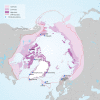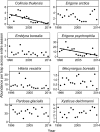Circumpolar terrestrial arthropod monitoring: A review of ongoing activities, opportunities and challenges, with a focus on spiders
- PMID: 31030417
- PMCID: PMC6989709
- DOI: 10.1007/s13280-019-01185-y
Circumpolar terrestrial arthropod monitoring: A review of ongoing activities, opportunities and challenges, with a focus on spiders
Abstract
The terrestrial chapter of the Circumpolar Biodiversity Monitoring Programme (CBMP) has the potential to bring international multi-taxon, long-term monitoring together, but detailed fundamental species information for Arctic arthropods lags far behind that for vertebrates and plants. In this paper, we demonstrate this major challenge to the CBMP by focussing on spiders (Order: Araneae) as an example group. We collate available circumpolar data on the distribution of spiders and highlight the current monitoring opportunities and identify the key knowledge gaps to address before monitoring can become efficient. We found spider data to be more complete than data for other taxa, but still variable in quality and availability between Arctic regions, highlighting the need for greater international co-operation for baseline studies and data sharing. There is also a dearth of long-term datasets for spiders and other arthropod groups from which to assess status and trends of biodiversity. Therefore, baseline studies should be conducted at all monitoring stations and we make recommendations for the development of the CBMP in relation to terrestrial arthropods more generally.
Keywords: Bioindicators; Climate change drivers; Community composition; Surrogates for biodiversity.
Figures



Similar articles
-
Nonlinear trends in abundance and diversity and complex responses to climate change in Arctic arthropods.Proc Natl Acad Sci U S A. 2021 Jan 12;118(2):e2002557117. doi: 10.1073/pnas.2002557117. Proc Natl Acad Sci U S A. 2021. PMID: 33431570 Free PMC article.
-
Arctic terrestrial biodiversity status and trends: A synopsis of science supporting the CBMP State of Arctic Terrestrial Biodiversity Report.Ambio. 2020 Mar;49(3):833-847. doi: 10.1007/s13280-019-01303-w. Ambio. 2020. PMID: 31955399 Free PMC article. Review.
-
Status and trends of terrestrial arthropod abundance and diversity in the North Atlantic region of the Arctic.Ambio. 2020 Mar;49(3):718-731. doi: 10.1007/s13280-019-01162-5. Epub 2019 Mar 16. Ambio. 2020. PMID: 30879270 Free PMC article.
-
Developing a circumpolar programme for the monitoring of Arctic terrestrial biodiversity.Ambio. 2020 Mar;49(3):655-665. doi: 10.1007/s13280-019-01311-w. Ambio. 2020. PMID: 31955398 Free PMC article.
-
Arthropods and climate change - arctic challenges and opportunities.Curr Opin Insect Sci. 2020 Oct;41:40-45. doi: 10.1016/j.cois.2020.06.002. Epub 2020 Jun 17. Curr Opin Insect Sci. 2020. PMID: 32674064 Review.
Cited by
-
Differences in Mobility and Dispersal Capacity Determine Body Size Clines in Two Common Alpine-Tundra Arthropods.Insects. 2020 Jan 22;11(2):74. doi: 10.3390/insects11020074. Insects. 2020. PMID: 31979048 Free PMC article.
-
Nonlinear trends in abundance and diversity and complex responses to climate change in Arctic arthropods.Proc Natl Acad Sci U S A. 2021 Jan 12;118(2):e2002557117. doi: 10.1073/pnas.2002557117. Proc Natl Acad Sci U S A. 2021. PMID: 33431570 Free PMC article.
-
Arctic terrestrial biodiversity status and trends: A synopsis of science supporting the CBMP State of Arctic Terrestrial Biodiversity Report.Ambio. 2020 Mar;49(3):833-847. doi: 10.1007/s13280-019-01303-w. Ambio. 2020. PMID: 31955399 Free PMC article. Review.
-
Herbivores in Arctic ecosystems: Effects of climate change and implications for carbon and nutrient cycling.Ann N Y Acad Sci. 2022 Oct;1516(1):28-47. doi: 10.1111/nyas.14863. Epub 2022 Jul 26. Ann N Y Acad Sci. 2022. PMID: 35881516 Free PMC article. Review.
-
Site-specific length-biomass relationships of arctic arthropod families are critical for accurate ecological inferences.PeerJ. 2023 Sep 6;11:e15943. doi: 10.7717/peerj.15943. eCollection 2023. PeerJ. 2023. PMID: 37692121 Free PMC article.
References
-
- Baldursson S, Ingadóttir AI, editors. Nomination of Surtsey for the UNESCO World Heritage List. Reykjavik: Icelandic Institute of Natural History; 2006.
-
- Bale JS, Hayward SAL. Insect overwintering in a changing climate. Journal of Experimental Biology. 2010;213:980–994. - PubMed
-
- Barrio IC, Bueno CG, Hik DS. Warming the tundra: Reciprocal responses of invertebrate herbivores and plants. Oikos. 2016;125:20–28.
-
- Böcher J, Kristensen NP, Pape T, Vilhelmsen L, editors. The Greenland entomofauna: An identification manual of insects, spiders and their allies. Leiden: Koninklijke Brill nv; 2015.
-
- Bolduc E, Casajus N, Legagneux P, McKinnon L, Gilchrist HG, Leung M, Morrison RIG, Reid D, et al. Terrestrial arthropod abundance and phenology in the Canadian Arctic: Modelling resource availability for Arctic-nesting insectivorous birds. Canadian Entomologist. 2013;145:155–170.
Publication types
MeSH terms
LinkOut - more resources
Full Text Sources

